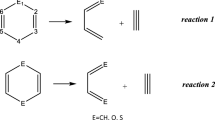Abstract
Thermal decomposition of N,N′-diphenylguanidine (DPG) was investigated by simultaneous TG/DSC-FTIR techniques under nonisothermal conditions. Online FTIR measurements illustrate that aniline is a major product of DPG decomposition. The observation that the activation energy depends on the extent of conversion indicates that the DPG decomposition kinetics features multiple processes. The initial elimination of aniline from DPG involves two pathways because of the isomerization of DPG. Mass spectrometry and thin film chromatography suggest that there are two major intermediate products with the major one of C21N3H17. The most probable kinetic model deduced through multivariate nonlinear regression method agrees well with the experimental data with a correlation coefficient of 0.9998. The temperature-independent function of conversion f(α), activation energy E and the pre-exponential factor A of DPG decomposition was also established through model-fitting method in this research.






Similar content being viewed by others
References
Sadequl AM, Ishiaku US, Poh BT. Cure index and activation energy of ENR 25 compared with SMR L in various vulcanization systems. Eur Polym J. 1999;35:711–9.
Kanne DB, Dick RA, Tomizawa M, Casida JE. Neonicotinoid nitroguanidine insecticide metabolites: synthesis and nicotinic receptor potency of guanidines, aminoguanidines, and their derivatives. Chem Res Toxicol. 2005;18:1479–84.
Otón F, Tárraga A, Molina P. A bis-guanidine-based multisignaling sensor molecule that displays redox-ratiometric behavior or fluorescence enhancement in the presence of anions and cations. Org Lett. 2006;8:2107–10.
Russell VA, Evans CC, Li WJ, Ward MD. Nanoporous molecular sandwiches: bonded networks with adjustable porosity. Science. 1997;276:575–9.
Schmidtchen FP, Berger M. Artificial organic host molecules for anions. Chem Rev. 1997;97:1609–46.
Kita T, Georgieva A, HashimotoY Nakata T, Nagasawa K. C 2-symmetric chiral pentacyclic guanidine: a phase-transfer catalyst for the asymmetric alkylation of tert-butyl glycinate Schiff base. Angew Chem Int Ed. 2002;41:2832–4.
Allingham MT, Howard-Jones A, Murphy PJ, Thomas DA, Caulkett PWR. Synthesis and applications of C 2-symmetric guanidine bases. Tetrahedron Lett. 2003;44:8677–80.
Terada M, Ube H, Yaguchi Y. Axially chiral guanidine as enantioselective base catalyst for 1,4-Addition reaction of 1,3-dicarbonyl compounds with conjugated nitroalkenes. J Am Chem Soc. 2006;128:1454–5.
Shen J, Nguyen TT, Goh YP, Ye W, Fu X, Xu J, Tan CH. Chiral bicyclic guanidine-catalyzed enantioselective reactions of anthrones. J Am Chem Soc. 2006;128:13692–3.
Olney JW, Labruyere J, Price MT. Pathological changes induced in cerebrocortical neurons by phencyclidine and related drugs. Science. 1989;244:1360–2.
Largent BL, Wikstrom H, Gundlach AL, Snyder SH. Structural determinants of sigma receptor affinity. Mol Pharmacol. 1987;32:772–84.
Guillén Schlippe YV, Hedstrom L. Guanidine derivatives rescue the Arg418Ala mutation of Tritrichomonas foetus IMP dehydrogenase. Biochemistry. 2005;44:16695–700.
Chang LC, Whittaker NF, Bewley CA. Crambescidin 826 and dehydrocrambine A: new polycyclic guanidine alkaloids from the marine sponge Monanchora sp. that inhibit HIV-1 fusion. J Nat Prod. 2003;66:1490–4.
Pfister T, Wimmer E. Characterization of the nucleoside triphosphatase activity of poliovirus protein 2C reveals a mechanism by which guanidine inhibits poliovirus replication. J Biol Chem. 1999;274:6992–7001.
Dubois SG, Messina J, Maris JM, Huberty J, Glidden DV, Veatch J, Charron M, Hawkins R, Matthay KK. Hematologic toxicity of high-dose iodine-131-metaiodobenzylguanidine therapy for advanced neuroblastoma. J Clin Oncol. 2004;22:2452–60.
Agnew R, Wilson SW, Stratton-Crawley R. Evaluation of flotation performance using variance spectrum analysis. Miner Eng. 1995;8:51–62.
Bruze M, Kestrup L. Occupational allergic contact dermatitis from diphenylguanidine in a gas mask. Contact Dermatitis. 1994;31:125–6.
Bempong MA, Hall AV. Reproductive toxicology of 1,3-diphenylguanidine: analysis of induced sperm abnormalities in mice and hamsters and reproductive consequences in mice. J Toxicol Environ Health. 1983;11:869–78.
Bempong MA, Mantley R. Body fluid analysis of 1,3-diphenylguanidine for mutagenicity as detected by Salmonella strains. J Environ Pathol Toxicol Oncol. 1985;6:293–301.
Kotler JM, Hinman NW, Richardson CD, Scott JR. Thermal decomposition behavior of potassium and sodium jarosite synthesized in the presence of methylamine and alanine. J Therm Anal Calorim. 2010;102:23–9.
Bertol CD, Cruz AP, Stulzer HK, Murakami FS, Silva M. Thermal decomposition kinetics and compatibility studies of primaquine under isothermal and non-isothermal conditions. J Therm Anal Calorim. 2010;102:187–92.
Bayram H, Önal M, Hamza Y, Sarıkaya Y. Thermal analysis of a white calcium bentonite. J Therm Anal Calorim. 2010;101:873–9.
Cabrales L, Abidi N. On the thermal degradation of cellulose in cotton fibers. J Therm Anal Calorim. 2010;102:485–91.
Burnham AK, Dinh LN. A comparison of isoconversional and model-fitting approaches to kinetic parameter estimation and application predictions. J Therm Anal Calorim. 2007;89:479–90.
Tanatani A, Yamaguchi K, Azumaya I, Fukutomi R, Shudo K, Kagechika H. N-methylated diphenylguanidines: conformations, propeller-type molecular chirality, and construction of water-soluble oligomers with multi-layered aromatic structures. J Am Chem Soc. 1998;120:6433–42.
Friedman HL. Kinetics of thermal degradation of char-forming plastics from thermogravimetry. Application to a phenolic plastic. J Polym Sci Part C. 1963;6:183–95.
Flynn JH, Wall LA. A quick, direct method for the determination of activation energy from thermogravimetric data. J Polym Sci Part B. 1966;4:323–8.
Ozawa T. A new method of analyzing thermogravimetric data. Bull Chem Soc Jpn. 1965;38:1881–6.
Kissinger HE. Reaction kinetics in differential thermal analysis. Anal Chem. 1957;29:1702–6.
Vyazovkin S. Modification of the integral isoconversional method to account for variation in the activation energy. J Comput Chem. 2001;22:178–83.
Vyazovkin S. A unified approach to kinetic processing of nonisothermal data. Int J Chem Kinet. 1996;28:95–101.
Opfermann J. Kinetic analysis using multivariate non-linear regression. J Therm Anal Calorim. 2000;60:641–58.
Zhang KL, Hong JH, Cao GH, Zhan D, Tao YT, Cong CJ. The kinetics of thermal dehydration of copper(II) acetate monohy-drate in air. Thermochim Acta. 2005;437:145–9.
Durbin J, Watson GS. Testing for serial correlation in least squares regression I. Biometrika. 1950;37:409–28.
Brown ME, Dollimore D, Galwey AK. Reactions in the solid state. In: Bamford CH, Tipper CFH, editors. Comprehensive chemical kinetics. Elsevier, Amsterdam; 1980. p. 340.
Acknowledgements
This work is supported through NSFC (21073133 and 20843007), Zhejiang Provincial Natural Science Foundation (Y4080177, Y4090248 and Y5100283) and Zhejiang Provincial Ministry of Education (Y200907715).
Author information
Authors and Affiliations
Corresponding author
Rights and permissions
About this article
Cite this article
Hu, Q., Jin, H.L., Chen, X.A. et al. Thermal and FTIR spectral studies of N,N′-diphenylguanidine. J Therm Anal Calorim 110, 593–599 (2012). https://doi.org/10.1007/s10973-011-1948-0
Received:
Accepted:
Published:
Issue Date:
DOI: https://doi.org/10.1007/s10973-011-1948-0




